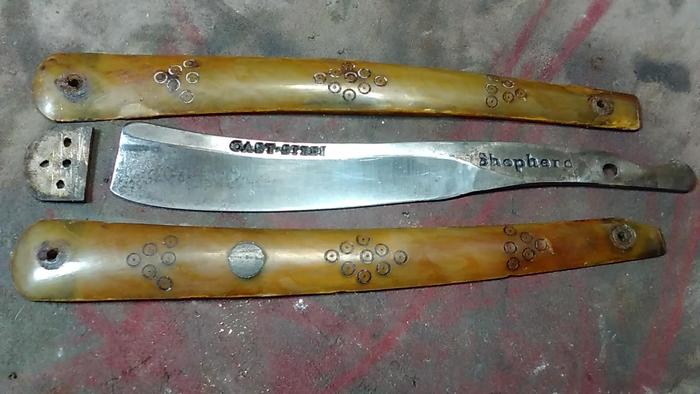Results 11 to 20 of 38
-
03-24-2021, 06:12 AM #11

Reduce weight and save material if cast could be cheaper, also could help add grip to the scales to prevent spinning with less pressure required, reducing risk of scales cracking etc
All theories all who know are probably long goneSaved,
to shave another day.
-
03-24-2021, 06:31 AM #12Senior Member

- Join Date
- Feb 2019
- Posts
- 102
Thanked: 7
What do you think, until what years was such a wedge used? 1820?
And since when did they start making such wedges?Last edited by esveka; 03-24-2021 at 06:44 AM.
-
03-24-2021, 03:46 PM #13Senior Member



- Join Date
- Apr 2012
- Location
- Diamond Bar, CA
- Posts
- 6,553
Thanked: 3215
What are the scales made from? Are you sure it is tin?
If the scales were an exotic material, like tortoise the wedge could be silver, and cast to minimize silver and still provide the required support.
Silver was often use for embellishments, inlays, cartouches/shields, collars and bolsters on quality, presentation razors.
You might test the metal with a gold/silver tester. I have not seen that on any lead wedges, nor wedges made of tin. Might be easier to date the razor and scales.
-
03-24-2021, 04:12 PM #14Senior Member

- Join Date
- Feb 2019
- Posts
- 102
Thanked: 7
No, no, no exotic stuff: horn and tin. Such wedges with a window are not an isolated case. They are found in stub tail razors.
As I could tell from the reactions of the other participants in this conversation, they also encountered such wedges.
-
03-24-2021, 05:17 PM #15

Good question
Was it done on purpose?
(easier work-ability & shaping, weight saving for better balance, material savings to lower the cost, etc.)
or was it a coincidence / a convenience (did they have something lying around and used that, recycling of something, etc.)
-
03-24-2021, 06:50 PM #16Senior Member

- Join Date
- Feb 2019
- Posts
- 102
Thanked: 7
Apparently, this risks remaining a mystery).
In razors of 1840-50 years, I definitely did not meet such wedges.
Either tin has fallen in price, or the balance sheet has become irrelevant, or the waste from other tin products has ended...
-
03-24-2021, 08:51 PM #17

I think they coincide with the "Old English" stamp ..1820-1825.. I have a few spare, all made of lead.
-
03-24-2021, 10:19 PM #18
-
03-25-2021, 03:57 AM #19

I think in the (horn) process, the scales were warm as-pinned on the bottom.
The holes and recesses took some scale material and made for a tight and even fitment.
Was the idea to keep the wedge from moving?
In the case of bone or ivory, likely the same reason as less metal to compress made for a tight, even, and lasting job.
-
03-25-2021, 04:36 AM #20Senior Member

- Join Date
- Feb 2019
- Posts
- 102
Thanked: 7


 90Likes
90Likes LinkBack URL
LinkBack URL About LinkBacks
About LinkBacks






 Reply With Quote
Reply With Quote

